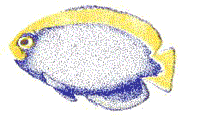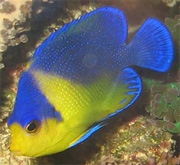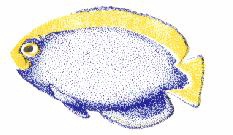|
JAWFISH, GOBIES, BLENNIES,
AND DRAGONETS
By Jim Wolf , MS.Marine Biology
The above four mentioned families contain over 2,000 representatives,
and dispite this variety they are all very similar. Most are small (2-3
inches) bottom dwelling species that eat small crustaceans or graze on
algae. In captivity they eat flake foods, brine shrimp and finely minced
high protien foods, and are generally very hardy. They prefer well established
aquariums with rocks to hide amoung as they are territorial at times. The
general rule is to stock them either singularly or in groups of three or
more. If they are paired the dominant one will probaly harass the submissive
one. There small size, docile nature and colorful appearence make them
good canidates for small aquariums, invertebrate aquariums, or tanks with
a mixture of docile species. Lets look at the four families.
Family Opistognathidae Jawfishes are secretive fishes that frequently
excavate burrows that they defend against all comers. Despite these displays
they are harmless and should be placed with other docile species. ever
place two of the same species together unless the tank is large. They need
a tank with lots of gravel to dig their burrows. There are about 30 species,
and some have been bred in captivity, and after mating the incubate the
eggs in their mouths! They are finicky at first, so watch their food for
the first few weeks.
Family Blennidae The Blennies are an immense group that all have
a single dorsal fin and cirri (small branching growths above the eyes.)
They are quite hardy and the 765 plus species show a variety of life styles.
The False Cleaner Wrasse ( Plagiotremus sp.) swims actively in the tank.
It advertises itself as a cleaner, but nips a piece of fin off the unsuspecting
fish that is expecting to be cleaned ! They need small crevises to hide
in and will fight amoung closely related species. Look closely at their
mouth and size to give you an idea as to specific points about their feeding
habits.
Family Gobiidae Gobies are the most specious of the fish families
with numbers in the 2,000 plus range! They can be distinguished from the
blennies by their double dorsal fin and the fact that their pelvic fins
are fused into a suction cup. At 1.2 cm the Pygmy Goby (Pandaka pygmea)
has the distinction of being the smallest vertebrate on earth! And the
Mudskipper (Periophthalamus sp.) is so well adapted to life on land that
it can be drowned if kept underwater. Their care and feeding is very similar
to blennies.
Family Callionymidae The Dragonette family includes the colorful
Mandarin "gobies" and the drab Scooter "blennies". They are slow feeders
and require a tranquel tank witha well established community of algae from
which they pick out small crustaceans and worms. An excellent addition
for reef aquariums, but make sure no one bothers them as there are reports
(not verified scientifically) that they may exude a toxin if harrassed.
|











